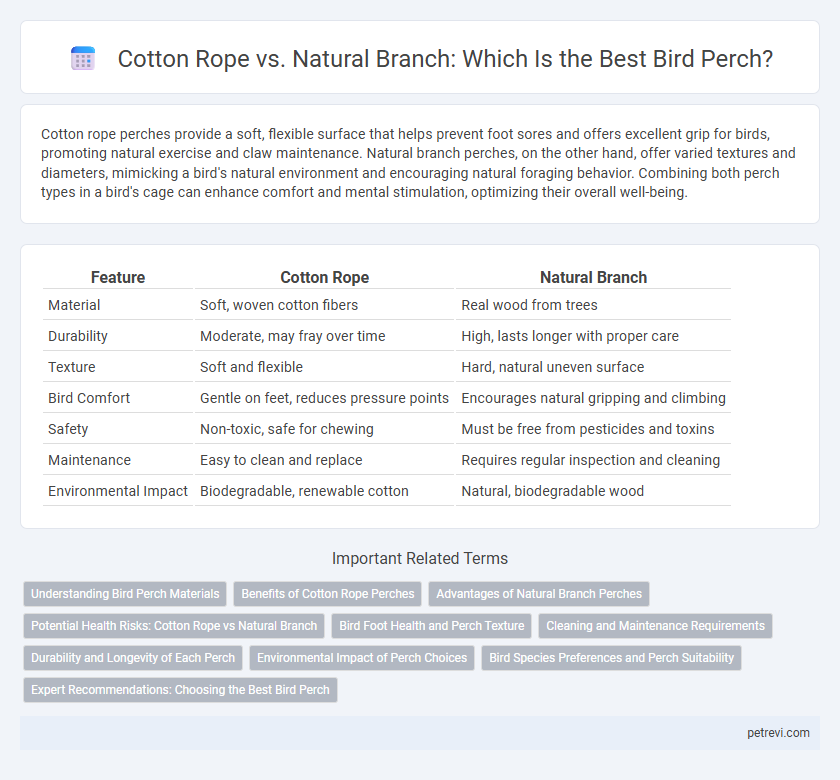Cotton rope perches provide a soft, flexible surface that helps prevent foot sores and offers excellent grip for birds, promoting natural exercise and claw maintenance. Natural branch perches, on the other hand, offer varied textures and diameters, mimicking a bird's natural environment and encouraging natural foraging behavior. Combining both perch types in a bird's cage can enhance comfort and mental stimulation, optimizing their overall well-being.
Table of Comparison
| Feature | Cotton Rope | Natural Branch |
|---|---|---|
| Material | Soft, woven cotton fibers | Real wood from trees |
| Durability | Moderate, may fray over time | High, lasts longer with proper care |
| Texture | Soft and flexible | Hard, natural uneven surface |
| Bird Comfort | Gentle on feet, reduces pressure points | Encourages natural gripping and climbing |
| Safety | Non-toxic, safe for chewing | Must be free from pesticides and toxins |
| Maintenance | Easy to clean and replace | Requires regular inspection and cleaning |
| Environmental Impact | Biodegradable, renewable cotton | Natural, biodegradable wood |
Understanding Bird Perch Materials
Cotton rope perches provide a soft, flexible surface that promotes foot health by preventing pressure sores and encouraging natural gripping behavior. Natural branch perches offer varying diameters and textures that help exercise bird feet and maintain nail strength, mimicking the bird's natural environment. Selecting perch materials that support foot hygiene and behavioral enrichment is essential for the well-being of pet birds.
Benefits of Cotton Rope Perches
Cotton rope perches provide a soft, flexible surface that helps prevent foot sores and promotes better grip for birds, enhancing their comfort and foot health. The absorbent texture of cotton rope also aids in moisture control, reducing the risk of bacterial growth and infections. Its lightweight and versatile design allow easy cleaning and repositioning, making it a hygienic and practical choice for bird perches.
Advantages of Natural Branch Perches
Natural branch perches offer birds a diverse texture that promotes healthy foot muscle development and natural gripping, reducing the risk of pressure sores. The irregular shapes and varying diameters mimic wild environments, encouraging natural behaviors and preventing boredom. These perches are also naturally abrasive, aiding in the maintenance of beak and nail health without introducing synthetic materials.
Potential Health Risks: Cotton Rope vs Natural Branch
Cotton rope perches may harbor bacteria and mold if not regularly cleaned, posing respiratory and skin infection risks to birds. Natural branches offer a more hygienic option as they dry quickly and have antimicrobial properties, reducing pathogen buildup. However, untreated branches can carry pesticides or parasites, so sourcing from safe, chemical-free trees is essential.
Bird Foot Health and Perch Texture
Cotton rope perches offer a soft, pliable texture that reduces pressure on bird feet and helps prevent sores, promoting healthier foot pads. Natural branches provide varied diameters and rough textures, encouraging exercise and natural foot alignment but may pose risks of splinters. Selecting a perch that balances softness with structural variety supports optimal foot health and prevents repetitive stress injuries in birds.
Cleaning and Maintenance Requirements
Cotton rope perches require frequent washing and thorough drying to prevent bacterial growth and mold, making maintenance a regular task for bird owners. Natural branch perches offer a more low-maintenance option, as their rough texture inhibits dirt buildup and they can often be wiped clean or replaced less frequently. Both materials need routine inspection to ensure safety and hygiene, but cotton rope demands higher attention to cleanliness due to absorbent fibers.
Durability and Longevity of Each Perch
Cotton rope perches offer moderate durability with a soft texture that gently wears down, promoting bird nail health but requiring frequent replacement due to fraying and potential fiber ingestion. Natural branch perches provide superior longevity and durability, maintaining firmness and texture over time while offering natural variations that support foot exercise and beak conditioning. Birds benefit from the sturdy, long-lasting nature of branches, although branches may need occasional cleaning to prevent mold or parasites.
Environmental Impact of Perch Choices
Cotton rope bird perches offer a biodegradable option that decomposes faster and reduces plastic waste compared to synthetic materials, promoting a lower environmental footprint. Natural branch perches are harvested directly from trees, which can support sustainability if sourced responsibly from fallen or pruned wood, preserving habitats and biodiversity. Choosing natural branch perches over cotton rope or synthetic alternatives minimizes synthetic fiber pollution and accelerates compostability, aligning with eco-friendly avian care practices.
Bird Species Preferences and Perch Suitability
Cotton rope perches provide a soft, textured surface favored by small to medium bird species such as budgerigars and canaries, promoting foot health and comfort. In contrast, natural branch perches offer varied diameters and irregular textures that appeal to woodpeckers and parrots, supporting natural gripping behavior and beak maintenance. Selecting perch material based on species-specific preferences enhances behavioral enrichment and prevents foot problems in captive birds.
Expert Recommendations: Choosing the Best Bird Perch
Experts recommend natural branches over cotton ropes for bird perches due to their varying diameters which promote healthy foot exercise and prevent pressure sores. Natural branches also provide a more authentic texture that meets birds' instinctual needs for chewing and climbing. Cotton ropes, while softer, may harbor bacteria if not regularly cleaned, making natural branches the preferred choice for optimal bird foot health and enrichment.
Cotton Rope vs Natural Branch for Bird Perch Infographic

 petrevi.com
petrevi.com